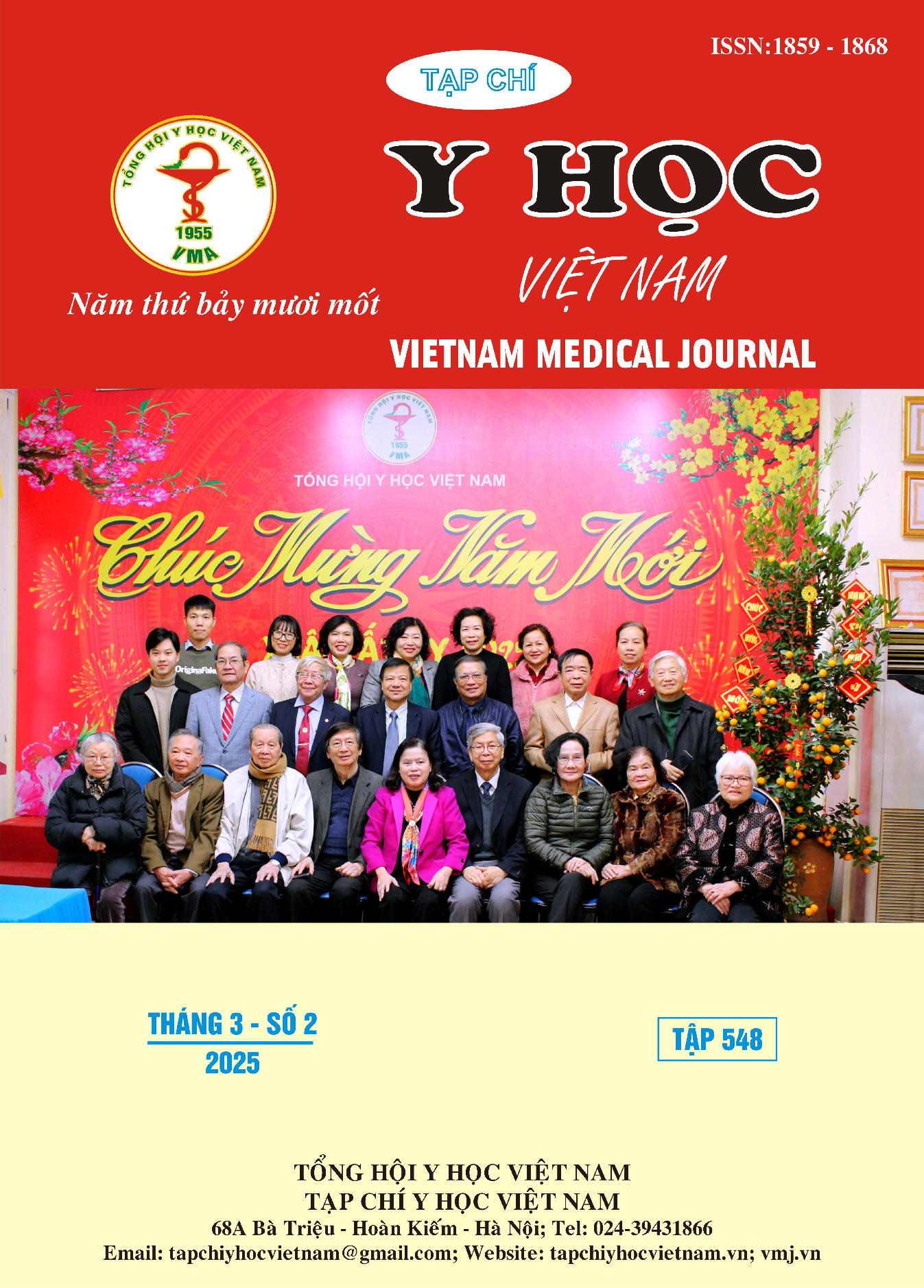CLINICAL AND PARACLINICAL CHARACTERISTICS OF OVARIAN TORSION IN PREGNANT WOMEN AT THE NATIONAL HOSPITAL OF OBSTETRICS AND GYNECOLOGY
Main Article Content
Abstract
Objective: To describe the clinical and paraclinical characteristics of ovarian torsion in pregnant women at the National hospital of Obstetrics and Gynecology. Subjects and Methods: A retrospective descriptive study was conducted on 73 medical records of pregnant women diagnosed with ovarian torsion after surgery at the National hospital of Obstetrics and Gynecology from January 1, 2019, to December 31, 2023. Results: The average age of participants is 30.8 ± 4.4 years. Ovarian torsion occurred in 50.7% of cases during pregnancies under 10 weeks, with the earliest case at 5 weeks. The incidence of ovarian torsion in primigravida is 57.7%. All pregnant women had abdominal pain, with severe abdominal pain reported in 69.9% of cases. Nausea and vomiting were observed in 57.2% of cases, most commonly in pregnancies under 10 weeks (57.1%). Blumberg sign was present in 50.7% of cases. The most ultrasound finding was an anechoic mass (61.6%). Right-sided ovarian torsion is more prevalent (63%). Torsion masses were most frequently 5–10 cm in size (64.4%). Absence of vascular signals on Doppler ultrasound was observed in 43.8% of cases. The time from symptom onset to hospital admission and the time from hospital admission to surgery were typically ≤24 hours in 83.6% and 79.5% of cases, respectively. Among patients tested for tumor markers, elevated levels of Ca-125, HE-4, and αFP were noted in 68.6%, 0%, and 50% of cases, respectively. Conclusion: Ovarian torsion in pregnant women predominantly occurs in the first trimester, with common symptoms including abdominal pain, nausea, vomiting, and abdominal wall reaction. Early detection and intervention are typical. Right-sided ovarian torsion is more frequent, and the condition is commonly associated with masses 5–10 cm in size. Ultrasound findings can assist doctors in early diagnosis of diseases; however, it need to be combined with clinical symptoms.
Article Details
Keywords
Ovarian torsion, pregnant women
References
2. Bider D, Mashiach S, Dulitzky M, Kokia E, Lipitz S, Ben-Rafael Z. Clinical, surgical and pathologic findings of adnexal torsion in pregnant and nonpregnant women. Surg Gynecol Obstet. 1991;173(5):363-366.
3. Raanan Meyer, Nir Meller, Daphna Amitai Komem, Abraham Tsur, Shlomo B.Cohen, Roy Mashiach & Gabriel Levin. Pregnancy outcomes following laparoscopy for suspected adnexal torsion during pregnancy. The Journal of Maternal-Fetal & Neonatal Medicine. Published online 2021. doi:10.1080/14767058.2021.1914574
4. Wang YX, Deng S. Clinical characteristics, treatment and outcomes of adnexal torsion in pregnant women: a retrospective study. BMC Pregnancy Childbirth. 2020;20(1):483. doi:10.1186/s12884-020-03173-7
5. Dvash S, Pekar M, Melcer Y, Weiner Y, Vaknin Z, Smorgick N. Adnexal Torsion in Pregnancy Managed by Laparoscopy Is Associated with Favorable Obstetric Outcomes. J Minim Invasive Gynecol. 2020;27(6):1295-1299. doi:10.1016/j.jmig.2019.09.783
6. Wu WF, Wang ZH, Xiu YL, Xie X, Pan M. Characteristics and surgical invervention of ovarian torsion in pregnant compared with nonpregnant women. Medicine (Baltimore). 2020;99(24):e20627. doi:10.1097/MD.0000000000020627
7. Rottenstreich M, Moran I, Hirsch A, et al. Factors Associated With Operatively Confirmed Adnexal Torsion Among Pregnant Women - A Multicenter Cohort Study. Ultraschall Med Stuttg Ger 1980.2022;43(6):e98-e104.doi:10.1055/a-1232-1378
8. Nguyễn Đức Hà. Nghiên cứu đặc điểm lâm sàng, cận lâm sàng và kết quả điều trị u buồng trứng xoắn tại bệnh viện phụ sản trung ương. Published online 2020.
9. Feng JL, Zheng J, Lei T, Xu YJ, Pang H, Xie HN. Comparison of ovarian torsion between pregnant and non-pregnant women at reproductive ages: sonographic and pathological findings. Quant Imaging Med Surg. 2020; 10(1):137-147. doi:10.21037/qims.2019.11.06
10. Han SN, Lotgerink A, Gziri MM, Van Calsteren K, Hanssens M, Amant F. Physiologic variations of serum tumor markers in gynecological malignancies during pregnancy: a systematic review. BMC Med. 2012;10:86. doi:10.1186/1741-7015-10-86


